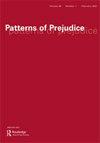在统一前的德国,“穆斯林”作为一个社会范畴的相关性
IF 0.8
2区 社会学
Q4 ETHNIC STUDIES
引用次数: 0
摘要
Sterphone的文章探讨了“穆斯林”在20世纪70年代和80年代作为日常德国人的社会类别的相关性和后果。具体来说,它检查了与“穆斯林”类别相关的特征和行为的常识性知识,并(重新)在报纸和演讲中产生。它表明,在1973年客工计划结束后,德国人对“土耳其人”的本质化部署并(重新)产生了他们同时被归类为“穆斯林”的能力。因此,德国人将“穆斯林”作为一种资源,(重新)产生关于不可调和的文明差异的分类知识。Sterphone的分析结合了话语分析和民族方法学方法来研究范畴和分类实践。由于范畴是“推理丰富的”,充当着关于社会世界的常识性知识的仓库,它们构成了各种社会行为的资源。本文表明,政治家和新闻记者不仅明确地将“穆斯林”作为(重新)构建和强调不可通约的社会差异的手段,而且还呼吁读者参与将这些特征和行为视为穆斯林所做或体现的事情。早在90年代难民涌入或9/11后的安全之前,这种做法就产生了“穆斯林”和“德国”这一相互排斥的类别。因此,斯特福恩的论文有助于研究德国的国家地位及其与种族、民族和宗教的交集。具体来说,它强调了德国战后与“西方”结盟的运动,因此,穆斯林土耳其人在德国西化计划中作为一个突出的他者的地位。因此,它有助于反穆斯林种族主义的理论和实证讨论,展示了德国人如何使用和(重新)产生“德国性”(Deutsch-Sein)和“穆斯林性”(Muslimisch-Sein),从而相互排斥。本文章由计算机程序翻译,如有差异,请以英文原文为准。
On the relevance of ‘Muslim’ as a social category in pre-unification Germany
ABSTRACT Sterphone’s article engages with the relevance and consequentiality of ‘Muslim’ as a social category for everyday Germans during the 1970s and 1980s. Specifically, it examines commonsense knowledge about the characteristics and actions bound to the category ‘Muslim’ and (re)produced in newspapers and speeches. It demonstrates that the German essentialization of ‘Turks’ following the end of the guest worker programme in 1973 deployed and (re)produced their simultaneous categorizability as ‘Muslims’. Thus Germans employed ‘Muslim’ as a resource for (re)producing category-tied knowledge about irreconcilable civilizational difference. Sterphone’s analysis combines discourse analysis with an ethnomethodological approach to studying categories and categorization practices. Since categories are ‘inference rich’ and act as storehouses for commonsense knowledge about the social world, they constitute resources for a variety of social actions. This paper demonstrates that not only did politicians and news journalists demonstrably orient themselves to the relevance of ‘Muslim’ as a means for (re)constructing and emphasizing incommensurable social difference, they also called on readers to participate in seeing these traits and behaviours as the kind of thing done or embodied by Muslims. Such practices produced the category ‘Muslim’ as mutually exclusive with ‘German’ long before the influx of refugees in the 1990s or the post-9/11 securitization. Thus Sterphone’s paper contributes to studies of German nationhood and its intersections with race, ethnicity and religion. Specifically, it highlights Germany’s post-war movement towards alignment with ‘the West’ and, consequently, the Muslim Turk’s position as a salient Other in Germany’s westernizing project. It therefore contributes to both theoretical and empirical discussions of anti-Muslim racism that demonstrate how Germans employ and (re)produce ‘Germanness’ (Deutsch-Sein) and ‘Muslimness’ (Muslimisch-Sein) so that they preclude one another.
求助全文
通过发布文献求助,成功后即可免费获取论文全文。
去求助
来源期刊

Patterns of Prejudice
Multiple-
CiteScore
2.50
自引率
0.00%
发文量
11
期刊介绍:
Patterns of Prejudice provides a forum for exploring the historical roots and contemporary varieties of social exclusion and the demonization or stigmatisation of the Other. It probes the language and construction of "race", nation, colour, and ethnicity, as well as the linkages between these categories. It encourages discussion of issues at the top of the public policy agenda, such as asylum, immigration, hate crimes and citizenship. As none of these issues are confined to any one region, Patterns of Prejudice maintains a global optic, at the same time as scrutinizing intensely the history and development of intolerance and chauvinism in the United States and Europe, both East and West.
 求助内容:
求助内容: 应助结果提醒方式:
应助结果提醒方式:


